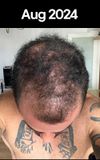community (M26) Can minoxidil alone maintain my hair for at least 3-4 years from now?
User with hair loss asks if minoxidil alone can maintain hair for 3-4 years. Replies suggest trying low dose topical finasteride and addressing insomnia with lifestyle changes.
